Tottenham came into this match with a great smile on their faces. Scoring 11 goals and conceding just two from the last previous two matches is the reason. Son Heung-Min started the season with zero goals in the seven opening matches of the league. In the span of just three weeks this December, he scored seven. He bagged a brace against Bournemouth in a thumping 5–0 win just days ago. Alongside him, the main protagonist, Harry Kane, also had his shooting boots on with three goals from two matches.
Meanwhile, Wolverhampton came into the Wembley game as the underdogs. Nuno Espirito Santo’s side lost 2-0 at home against Liverpool on 23 December. Prior to this match, they had failed to beat relegation battlers Fulham, only drawing 1–1. In the previous encounter at Molineux, Wolves were the inferior side; they lost 2–3 after a hard second-half battle.
Tottenham also came into this game with high expectations, a win necessary to keep their title ambitions alive. A slip for Manchester City at Selhurst Park gave them a moral boost facing this match. Unfortunately, the result was very far from what they hoped. The visitors bagged a convincing 3-1 comeback win with all their goals scored in the last 20 minutes of the game. What happened to Tottenham?
Starting XI
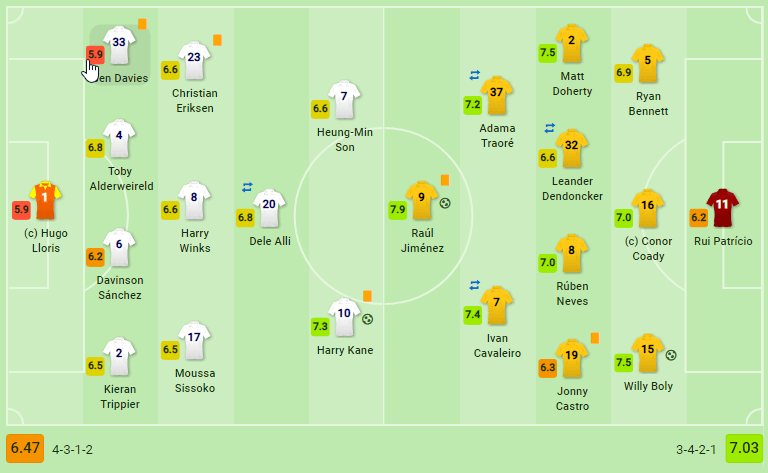
Mauricio Pochettino brought his best possible players into this match, with only Mousa Dembele missing from the teamsheet. Christian Eriksen started in the middle of the park alongside Harry Winks and Moussa Sissoko. On-fire Kane started in front of Son and Dele Alli. On the bench, there were Lucas Moura, Danny Rose, and promising right-back Kyle Walker-Peters.
Leander Dendoncker got a chance to start this match ahead of Joao Moutinho, who moved to the bench. The Belgian was paired with Neves in midfield. Up front, Raul Jimenez was flanked by Ivan Cavaleiro and Adama Traore. Helder Costa and U-17 World Cup Champion, Morgan Gibbs-White, also started from the bench.
Pochettino’s approach
Spurs started the game with a 4–2–3–1, using Winks and Sissoko as a double pivot. Eriksen started just behind Kane while Son and Alli filled both flanks.
Actually, Spurs were very fluid throughout the game. They used 4–1–2–3, 4–3–3, 4–2–1–3, and 4–3–2–1. Eriksen often dropped alongside the two defensive midfielders in order to help Spurs in build-ups. Son and Alli also actively moved into the inside channels whenever needed.
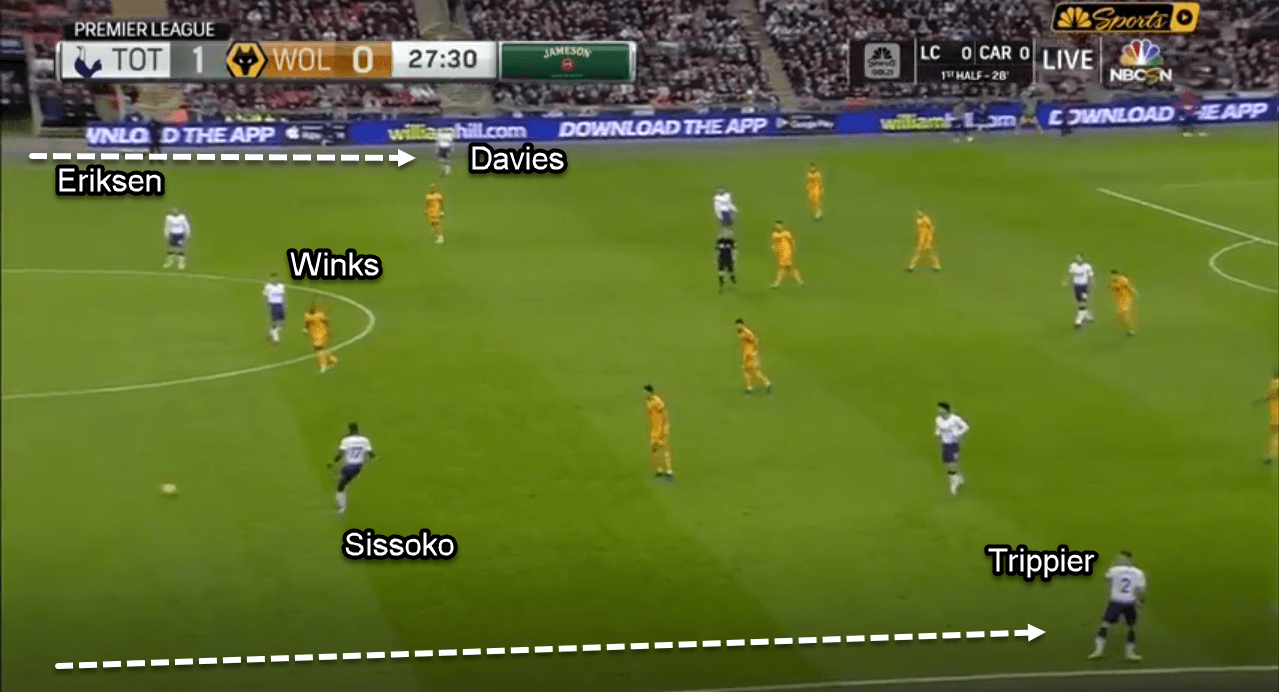
Off the ball, Spurs rotated between 4–3–3 and 4–3–2–1 with narrow forwards. Sometimes Kane switched positions with Son when Wolves re-started their attacks from the back.
How about Nuno’s?
The visitors started the game with 3–4–3 on paper. As Spurs enjoyed the lion’s share of possession in the first half, they would sit in a 5–4–1 mid-block, with Adama and Cavaleiro joining the midfield. The men in gold were quite passive off the ball with very little pressure on Toby Alderweireld, Davinson Sanchez, and Winks.
Offensively, the away side’s forwards were tasked with less defensive duty. They were instructed to stay high to pin Spurs’ defenders back. Using Traore’s ball-carrying ability, Wolves focused their attack on Spurs’ left-side defence, particularly Ben Davies. This worked quite well in the opening 20 minutes: Davies got booked after a clumsy tackle against Matt Doherty.
Wolves could have got more in the first half but the lack of good decision-making from Adama prevented that. Plus, Nuno’s wing-backs rarely joined the attack, especially after 15 minutes or so. This left the forwards with no support whatsoever in transitions.
Space invaders (or not)
Wolves’ defensive department was not good as they allowed so much room for Spurs’ attackers between the lines. With smart players like Eriksen, Son, Alli, and Kane, the home side exploited this area freely in the first half. Winks (and Eriksen, when dropping) was tasked with feeding the attackers with his pin-point passes.
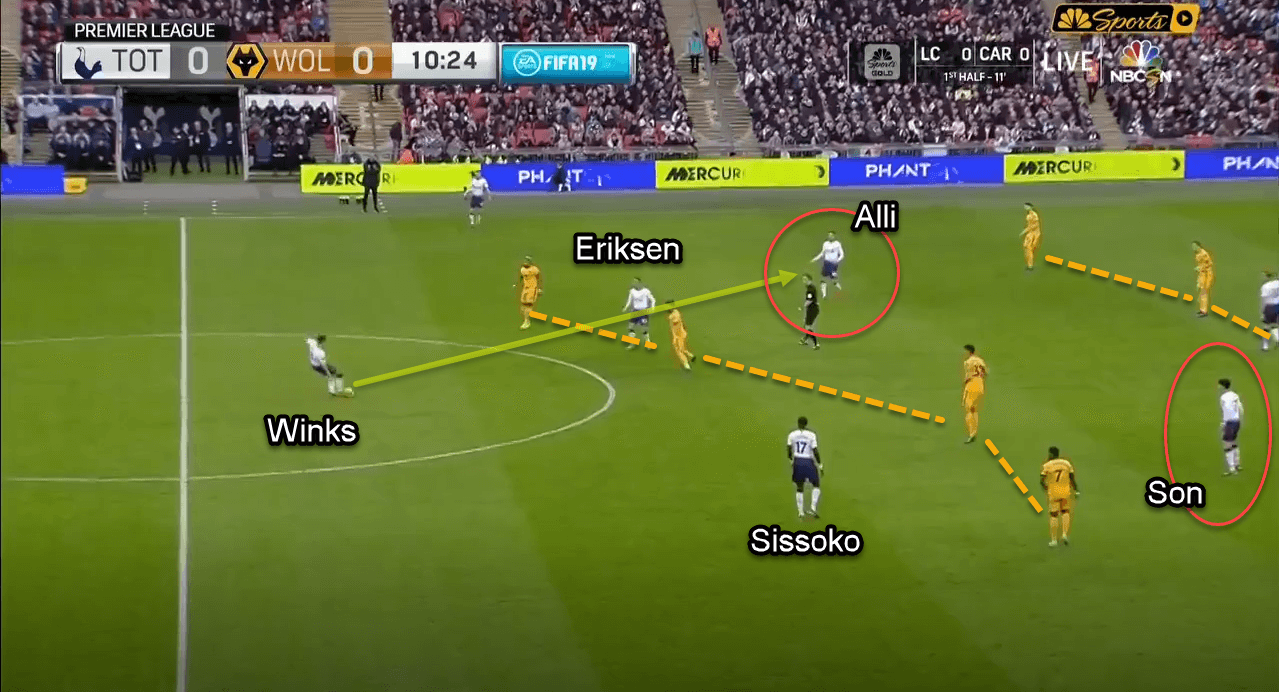
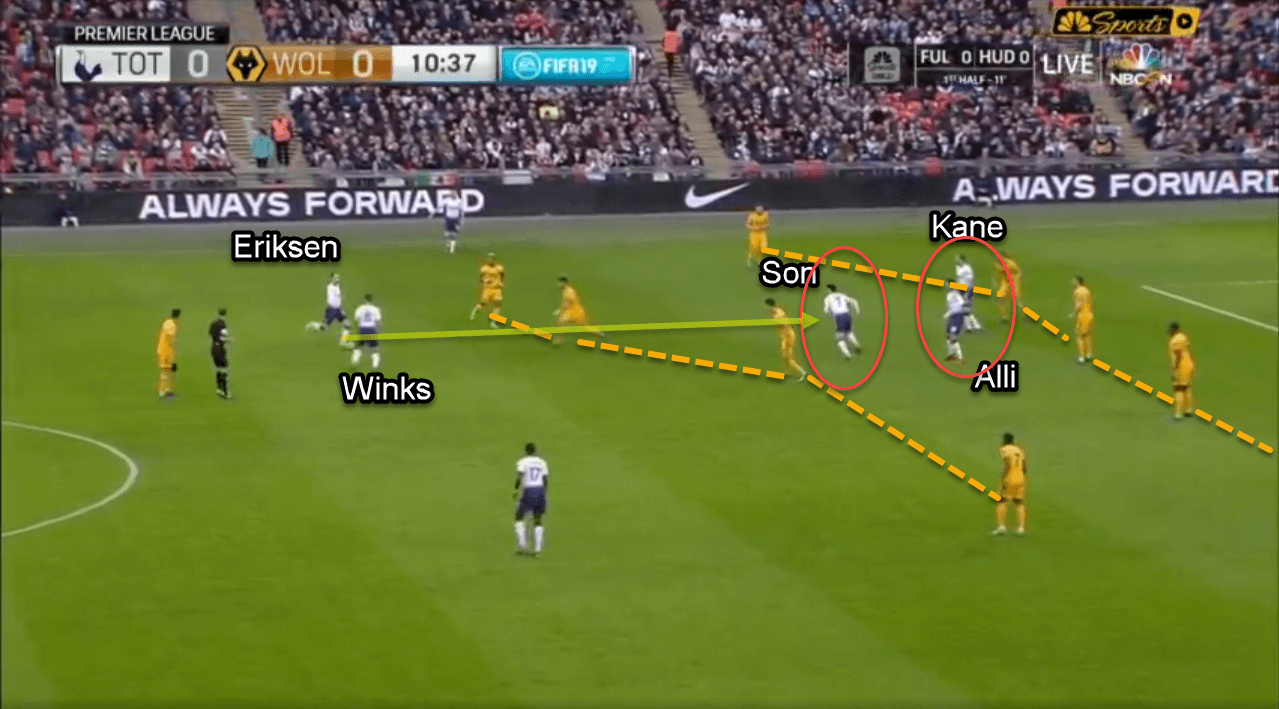
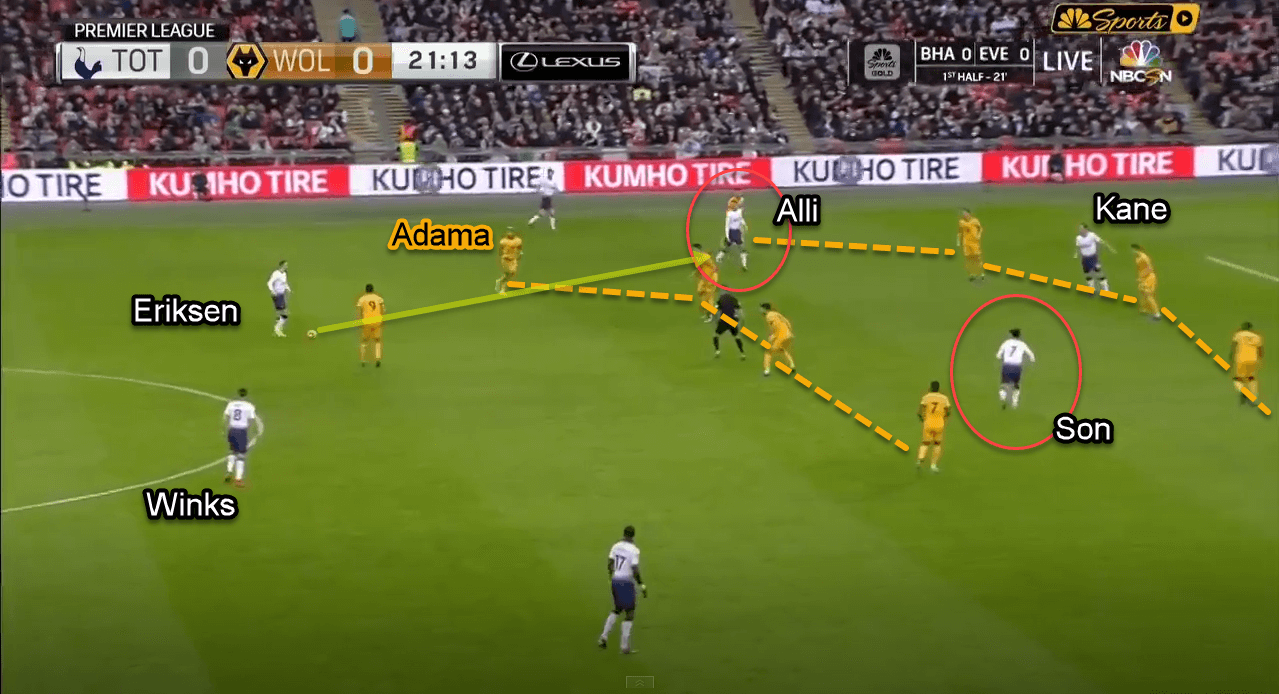
Surprisingly, even though Wolves gave away so much space between the lines, Spurs failed to create many dangerous chances despite this huge advantage. The trio of Son-Kane-Alli bizarrely couldn’t combine properly there. They couldn’t even force their way into Wolves’ penalty box. They were toothless, rather than ruthless.
Their dipping performance in the final third maybe resulted from Wolves’ tendency to protect the box rather than protecting the area in front of it. This allowed Spurs absolute no shots from inside the box throughout the game. They allowed Spurs to make a lot of less-dangerous attempts from outside the box.
Maybe it also resulted from the misuse of Son Heung-min. The Korean is capable of working in central areas, but he’s at his best when he plays at his favourite position on the wing. The Asian Games gold-medalist looked a bit uncomfortable behind Kane and tended to drift wide in the first half.
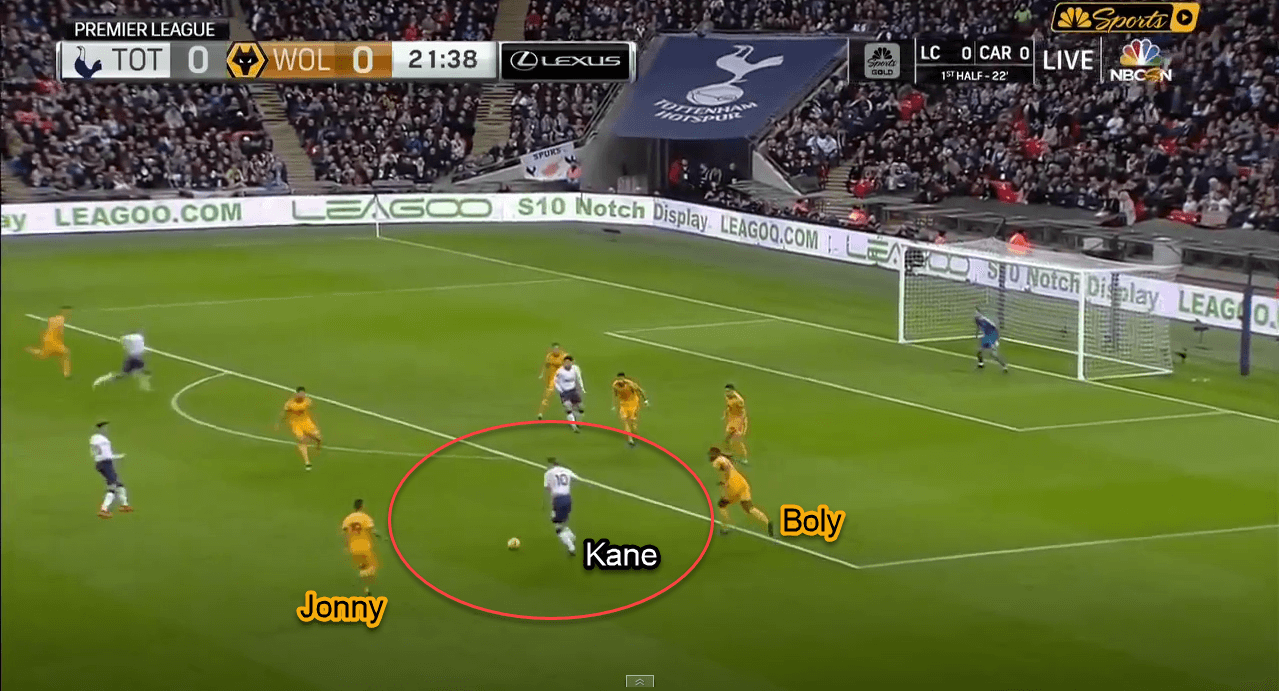
Wolves’ focus to protect the box was finally punished. After Winks forced a turnover in midfield, Kane got the ball and carried it until near the 18-yard box. He chopped the ball inside under no pressure from Wolves’ left centre-back, Willy Boly. One second later, the ball ended in the back of the net after a stunning strike from the captain. Perhaps this one was a moment of magic from the joint top-scorer, though. After this goal Spurs were not able to make even a single promising attempt on Rui Patricio’s goal.
Let’s try something different
Not only trying to invade the space between Wolves’ lines, Pochettino also brought more from his playbook. In this approach, he asked one of his wingers to run in behind. The rushing attacker then would be provided with a diagonal ball from deep, from one half-space to another. This approach was used to stretch the defenders, destabilise them, and open more space in front of them to exploit.
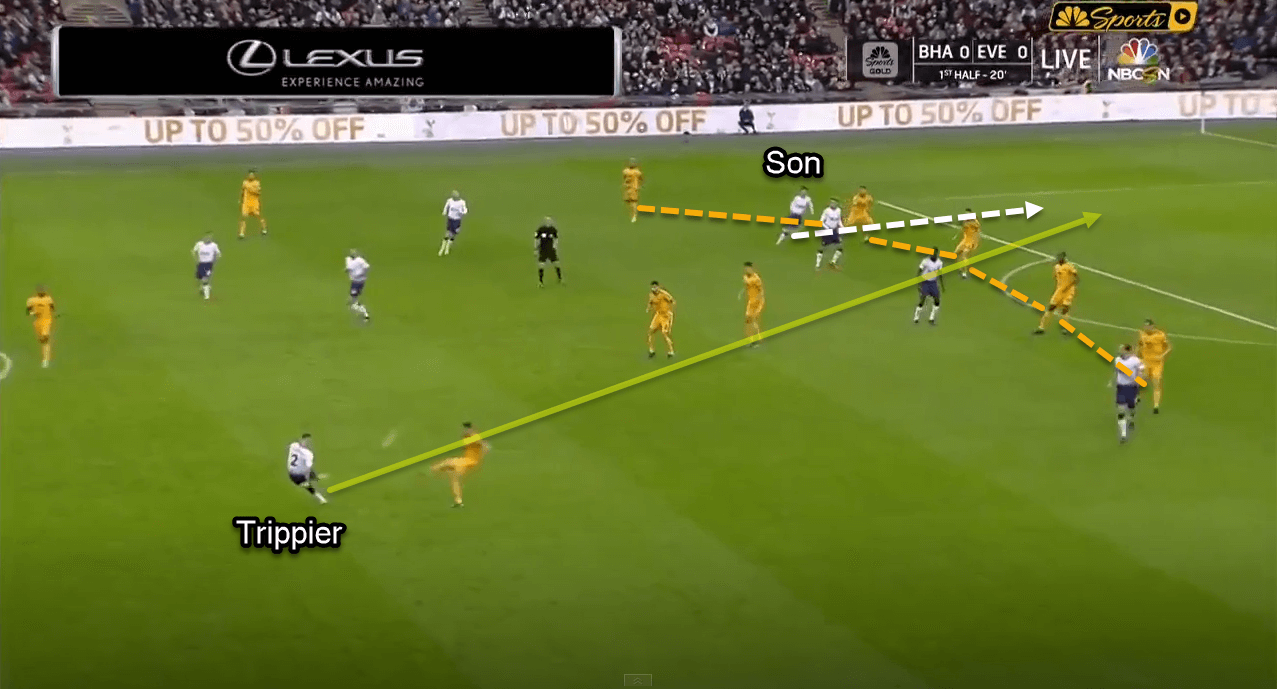
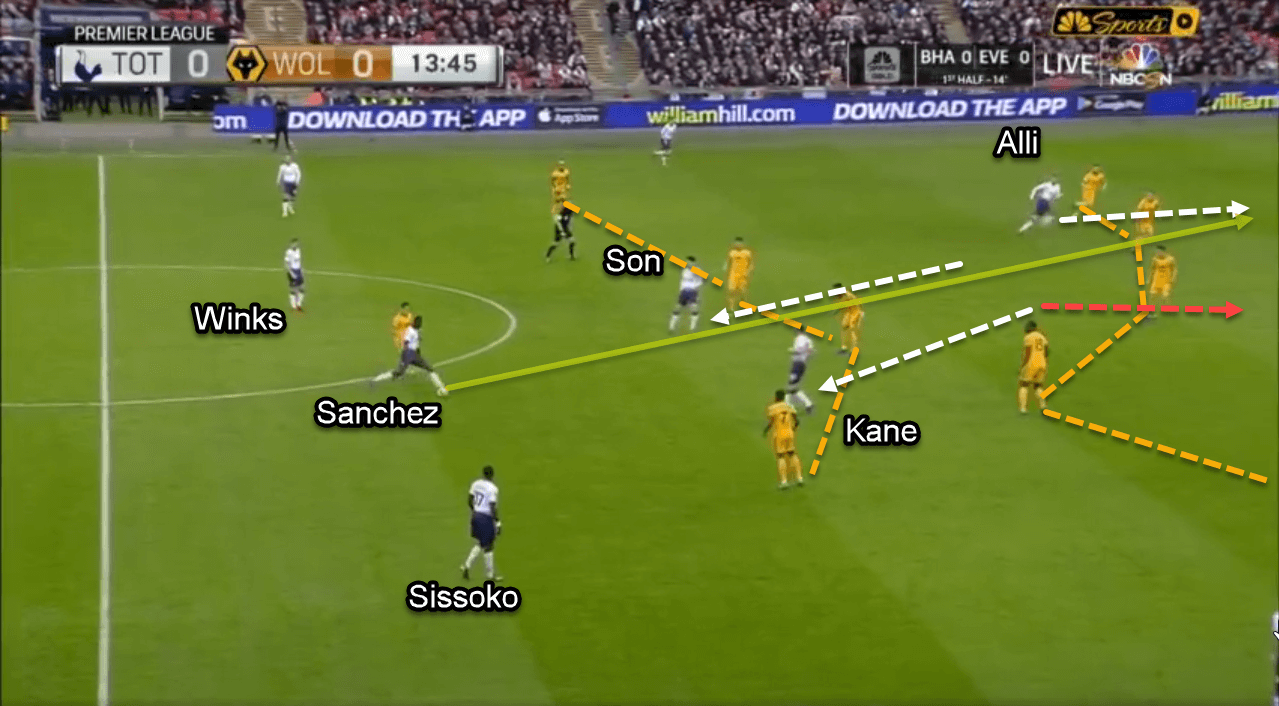
In the image above, however, both Son and Kane dropped from the danger zone looking for the ball to be played into feet. This left Alli to face three defenders without any support. Kane should have moved in the red dotted lines, in order to support Alli and give him more offensive options.
This approach was used a handful of times to little effect. The best result they got was releasing Alli or Son with a ball near Wolves’ box. After that, they would lose the ball, either by a blocked speculative attempt or a tackle by one of Nuno’s men.
4-3-2-1
Out of possession, Pochettino used his version of the 4-3-2-1 Christmas Tree formation popularised by Carlo Ancelotti during his Milan years. Zlatko Dalic used one too for his Croatia side in the World Cup earlier this summer. Spurs used the shape both in their counter-presses, and when they were sitting in their mid-block. This gave them an advantage in the middle of the park by making an overload centrally.
This shape worked quite brilliantly in the first half. Spurs’ players were able to slow down Wolves’ build up and force them to play wide. When their opponents moved wide, Spurs’ near-side wing-back would close down the opponent’ mirror-side wing-back.
The 4-3-2-1 also prevented Wolves from breaking Spurs down through the central part of the pitch. When Wolves boldly tried that, Spurs’ midfielders were always able to force turnovers. One of the turnovers forced by Winks eventually lead to Kane’s goal.
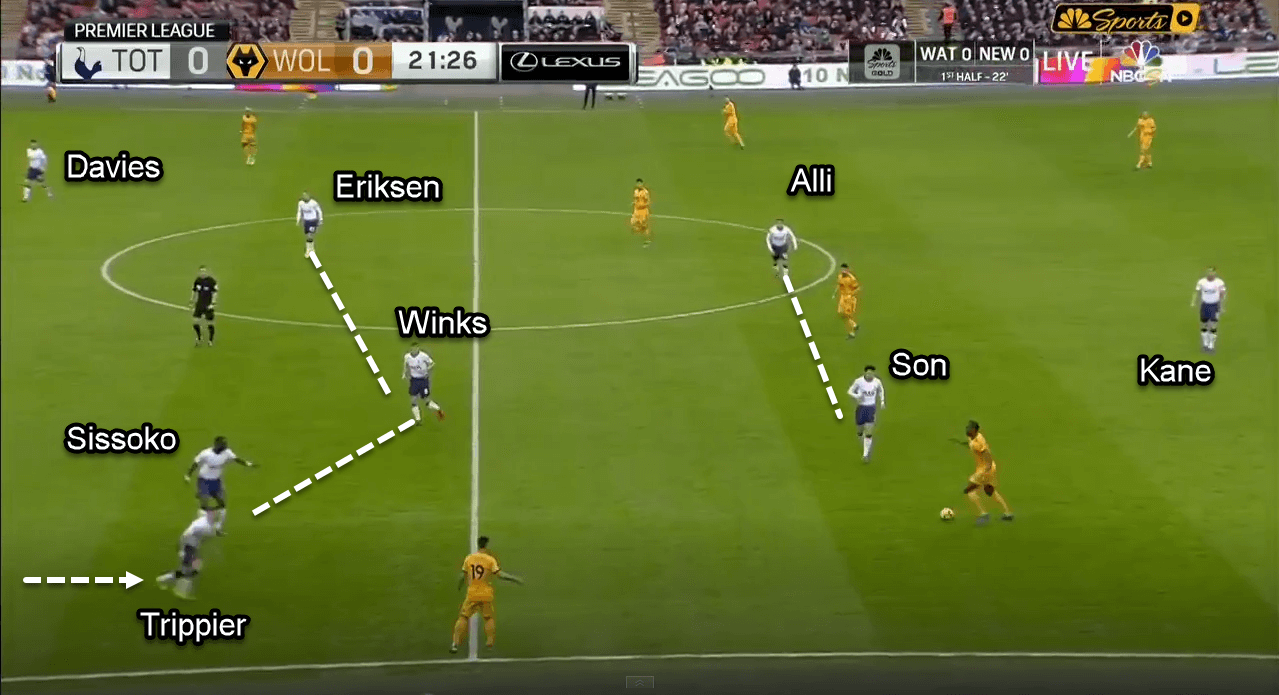
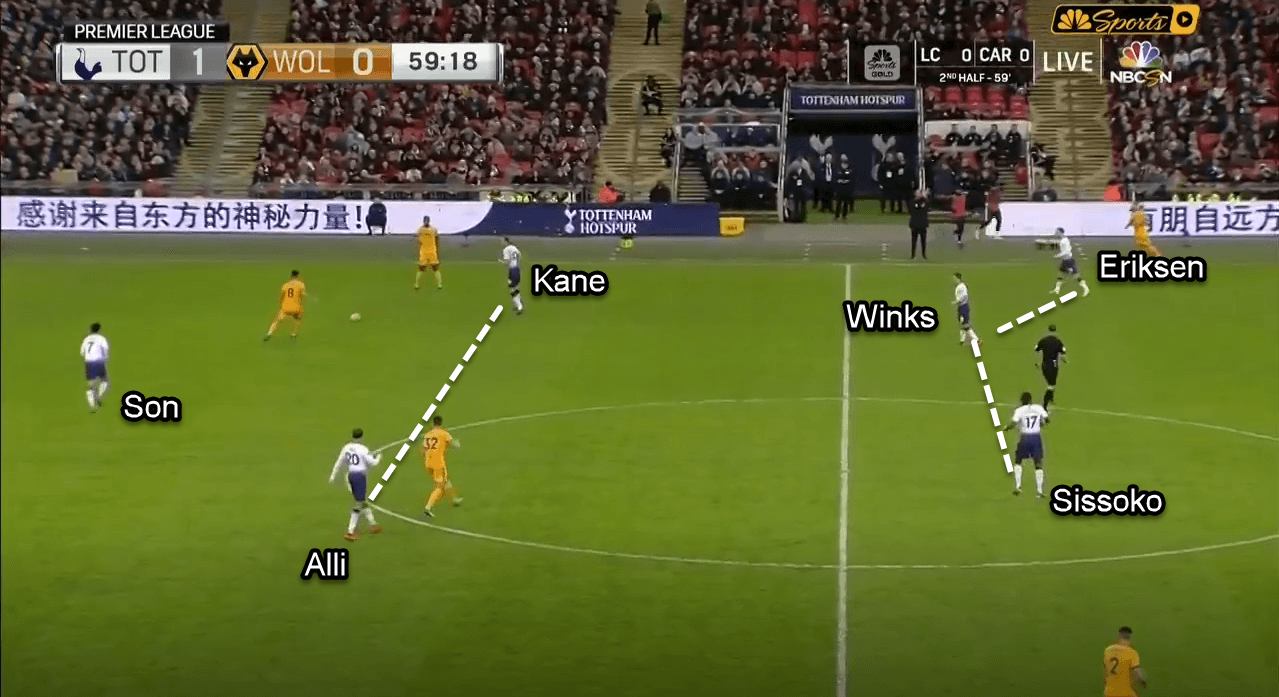
Actually, this shape had natural issues. In 4–3–2–1, the three midfielders have to cover a lot of ground, often neglecting the wide areas. Any overloads there will cause a serious problem for the team using 4–3–2–1. That’s exactly what happened to the trio of Sissoko-Winks-Eriksen. In the first half, they didn’t face a lot of threats since both Doherty and Jonny rarely joined the attack but the danger was there; it would come later.
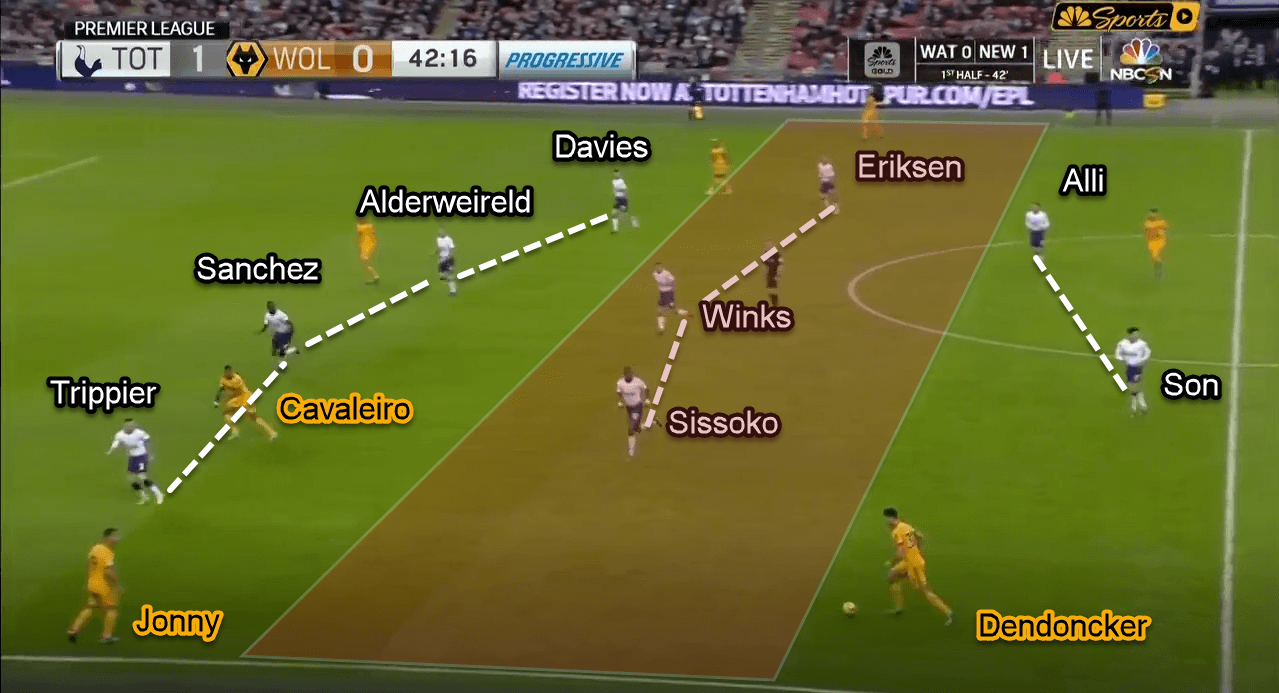
In the second half, Wolves came out from their shell. Nuno tasked his wing-backs to join the attack, with Doherty the more attacking. He often made runs into the half-spaces, even high between Alderweireld and Davies in order to pin them back and open the flank for Helder Costa (who had been subbed on previously for Traore).
Nuno instructed Conor Coady to provide diagonal balls to both flanks, especially into the right-hand side, with Doherty and Costa as the receivers. This wing play exploited Spurs completely in the second half.
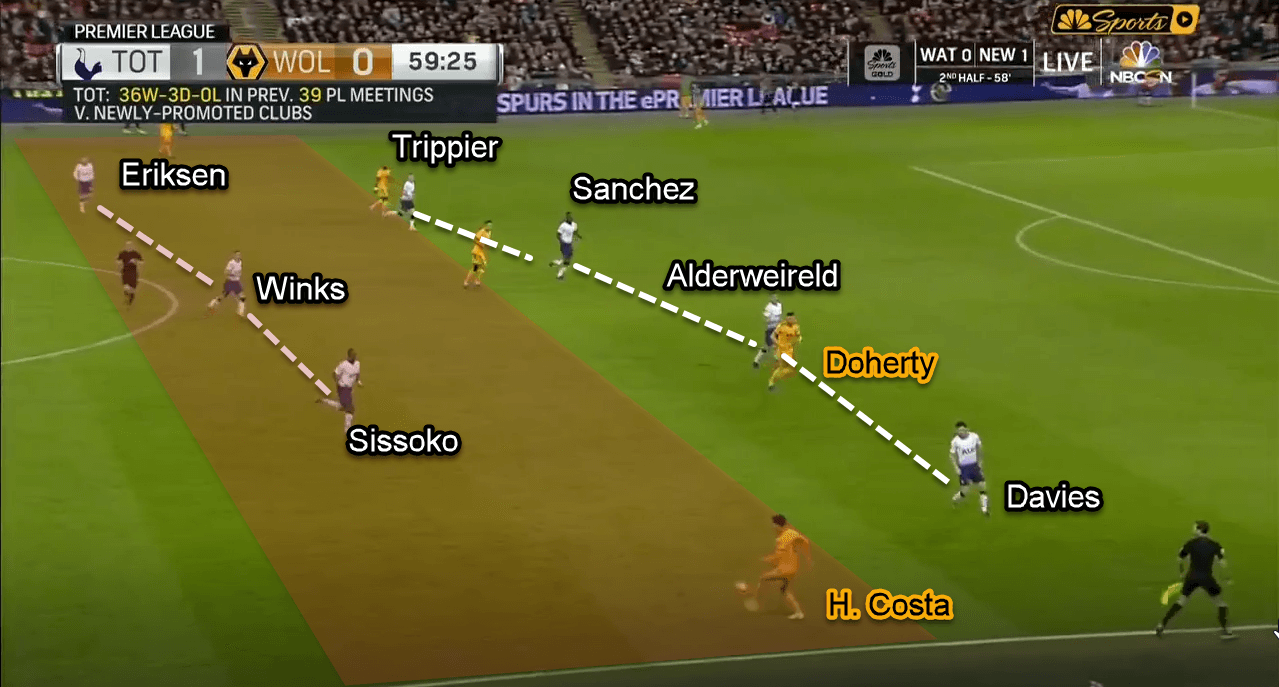
From bad to worse
In the second half, Nuno changed his team’s defensive shape to a narrower 5–4–1, or even more like a 5–2–2–1. This shape finally enabled Wolves to outnumber Pochettino’s men in midfield, with four men to three. Nuno also asked his wing-backs to be more aggressive, by preventing their opposite numbers from receiving comfortably, just like Pochettino had done in the first half. The gap between the midfielders and the defenders was still there, but definitely less visible than before. The former Southampton manager almost had no answer for this adjustment.
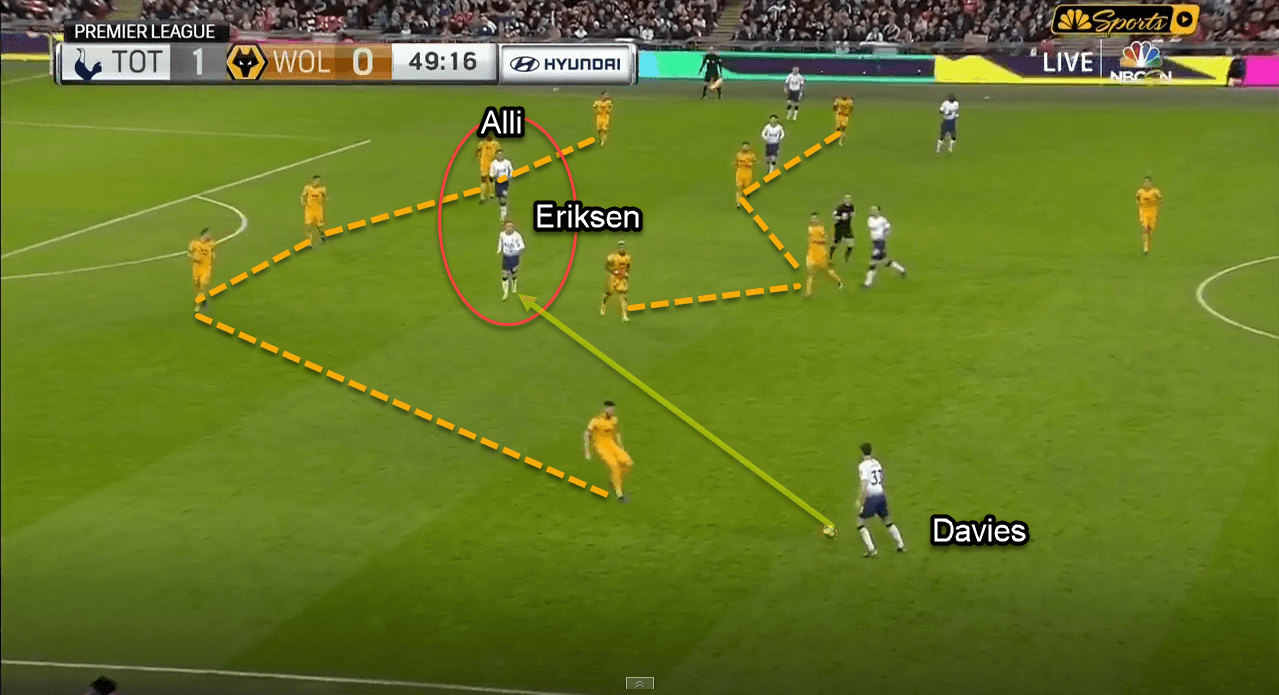
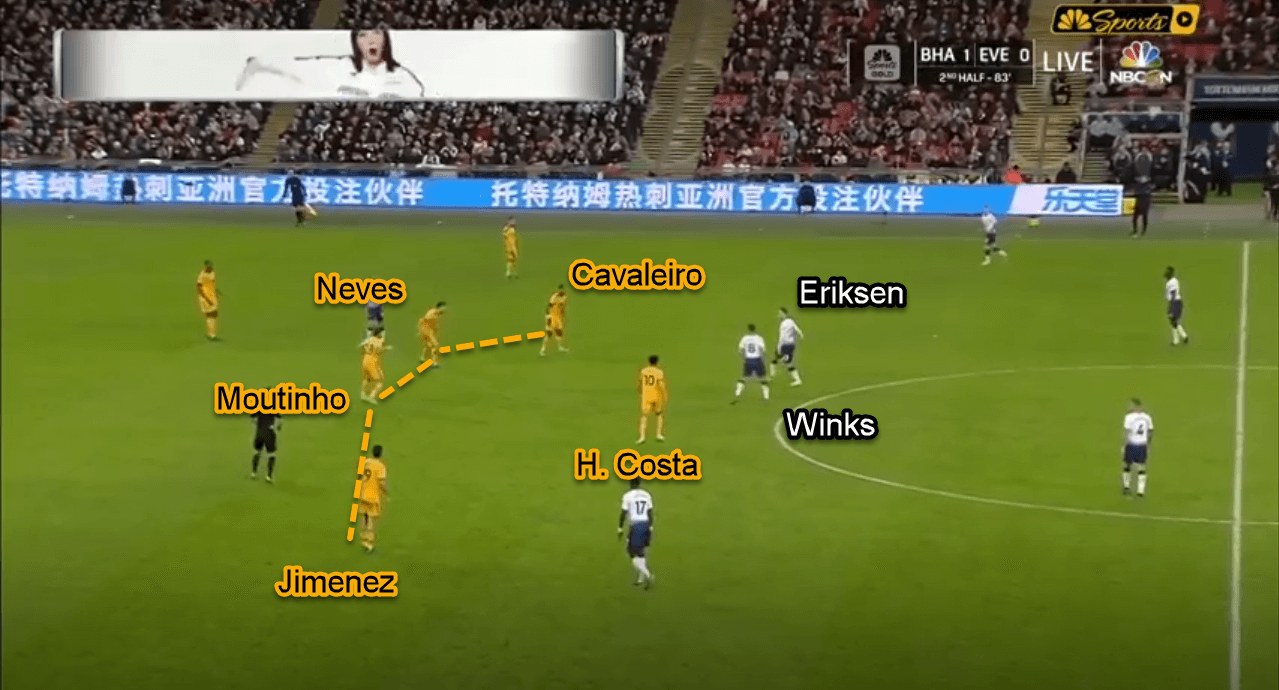
Wolves’ narrower 5–4–1 proved effective, especially after Joao Moutinho was introduced for Dendoncker. The veteran showed his class by controlling the midfield both offensively and defensively, even providing an assist for the visitors’ opening goal. In the picture above, the narrow 5–4–1 employed by the away side forced Spurs’ midfield to make a turnover in possession. The turnover eventually leads to Jimenez’s goal, thus giving Wolves the lead.
Worrying Winks
Winks played well in the first half. He was the main cog in the Lilywhites’ engine room. He sometimes dropped between the centre-backs to make a 3v2 situations against Wolves’ attackers. His passing ability was supreme to say the least, enabling him to take control for his team’s ball distribution.
One issue he showed was his mobility. He was mobile, but perhaps too mobile. In the first half, sometimes he moved beyond Eriksen and Sissoko in possession. One time, he carried the ball forward and combined with Sissoko, leaving Eriksen alone in front of the defence to protect a possible counter-attack. Sissoko lost the ball quite easily, then forced Eriksen to play 1v1 against Traore. The Dane ended up in the referee’s book.
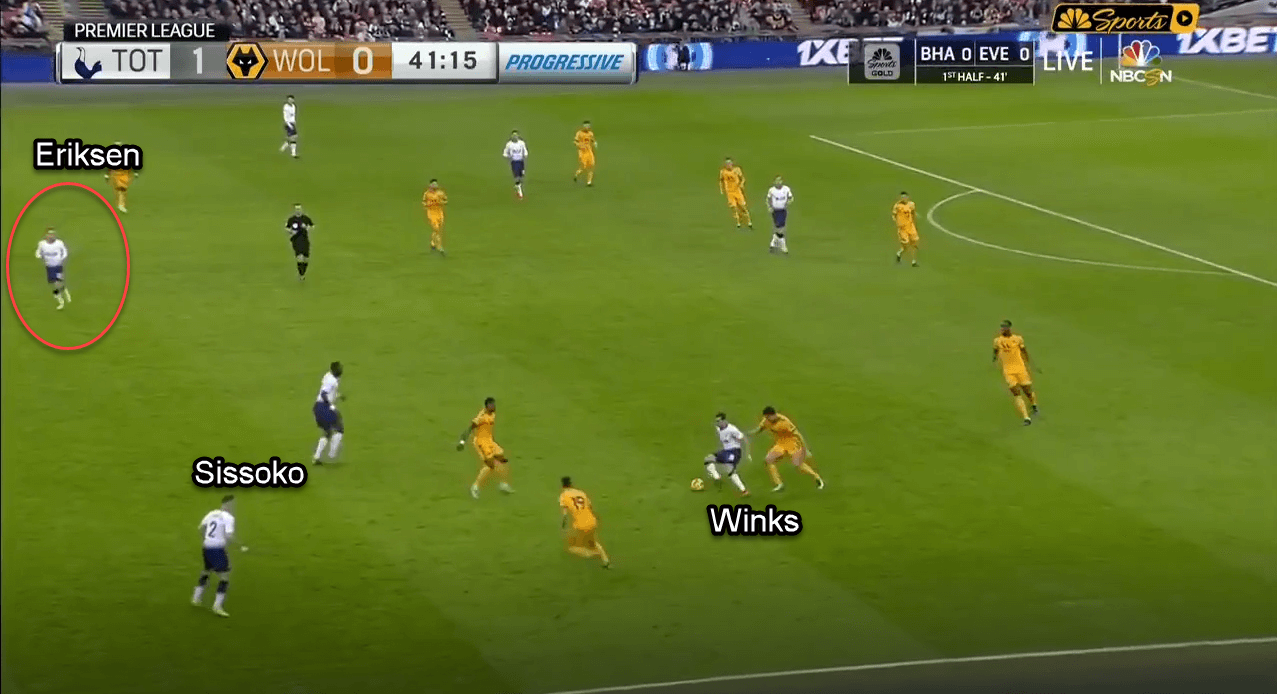
Winks showed more and more problems in the second half. He looked exhausted, and definitely lost control of the midfield after Moutinho came in for the away side. His fatigued legs made him late to cover Jimenez in the build-up of Wolves’ opening goal. He should have arrived more quickly in order to close down Jimenez. Instead, he jogged his way back from the halfway line.
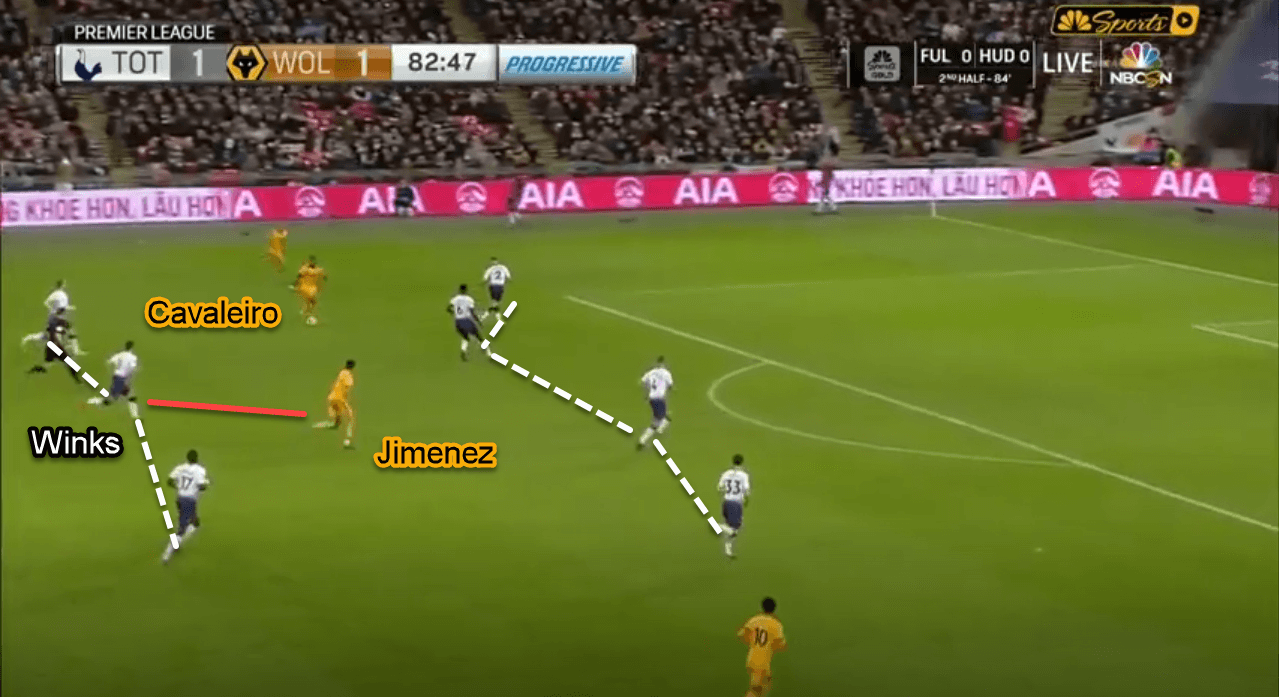
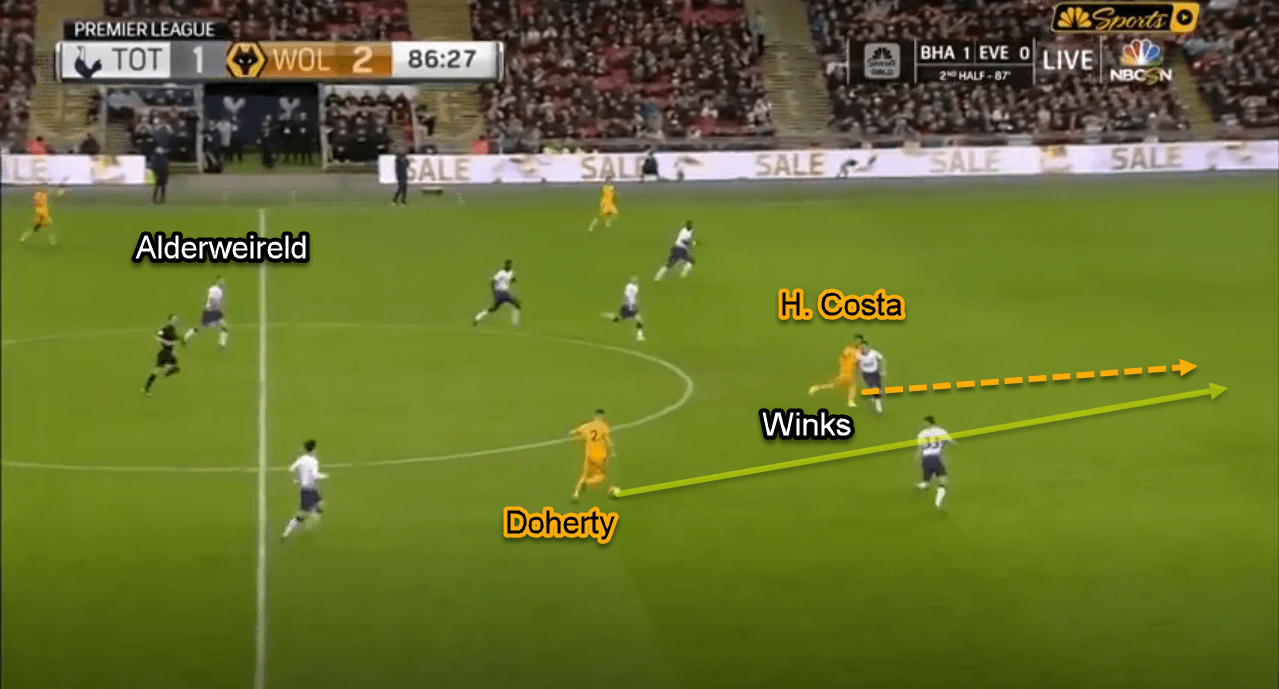
Too late, Mr. Pochettino
Even after bringing on Lucas Moura for the under-performing Alli, Pochettino was still unable to add creativity to his team. The actual change came after 82 minutes. The Argentinian manager moved Son to his favourite position in the left wing. Alongside that, Pochettino also moved Davies inside into the left half-space. This allowed Son to receive diagonal balls from the back, therefore having a 1v1 against Doherty.
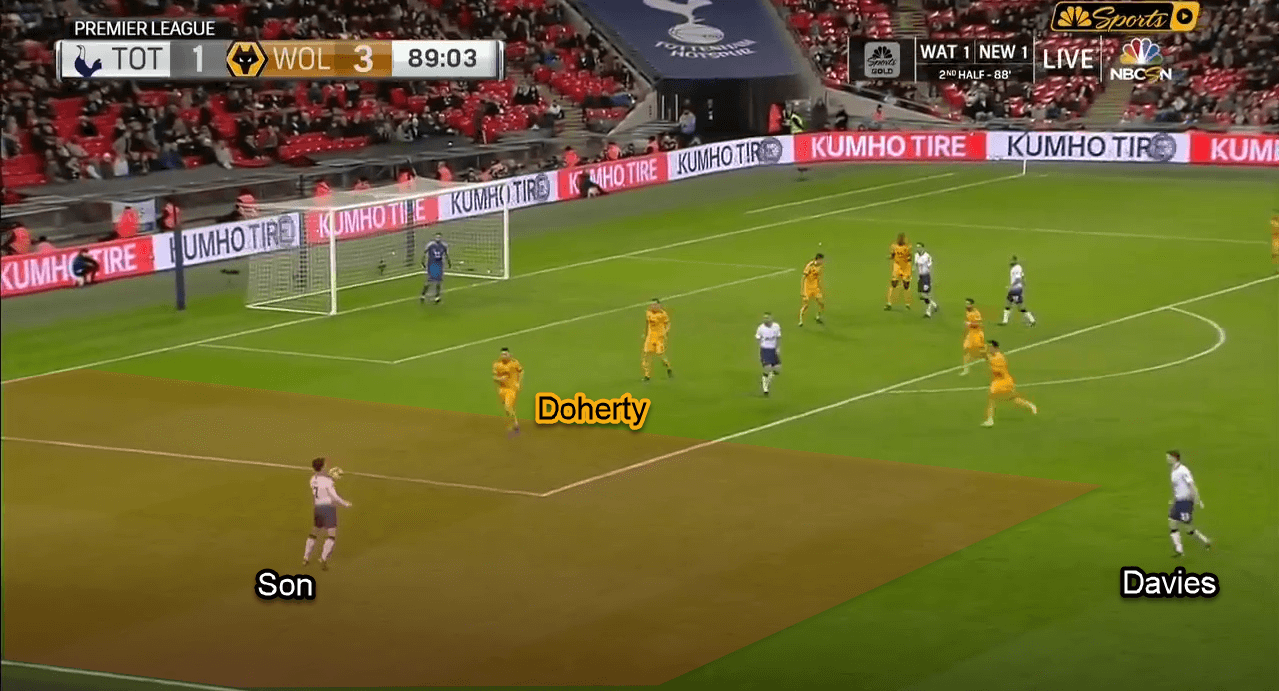
With eight minutes of normal time in his pocket, Son had to show what he could do in his favoured position. Because of Wolves’ second and third goals, the situation as pictured above became more evident in the last three minutes of the game. What could a normal winger create from that?
The Korean proved that he’s not a normal winger. He was able to beat Doherty twice in a 1v1; one resulted in a corner kick, and one resulted in a dangerous cross to Kane. Kane, who was brought down by Boly when trying to head the cross, appealed for a penalty but was denied. It was too late anyway.
Conclusion
Pochettino’s side failed to close the year with a positive result, partly because of fatigue. Even though they controlled the first half, Spurs were lacking the cutting edge needed to break Wolves’ defensive wall down. Pochettino is also responsible for his failure to adjust to Nuno’s changes. He did actually, but it was too late. Had Son been allowed to play as a left winger earlier, a more positive result would have definitely been in reach.
Pochettino has to learn from this game, especially from the opposition manager’s boldness. Nuno’s bravery to start Moutinho from the bench, and his patience to wait until the second half to unleash the wing-backs, have to be appreciated. Both moves were effective for the away side, who close the year happily in seventh place.
It’s not easy but the title is race is not over.
If you love tactical analysis, then you’ll love the digital magazines from totalfootballanalysis.com – a guaranteed 100+ pages of pure tactical analysis covering topics from the Premier League, Serie A, La Liga, Bundesliga and many, many more. Get your copy of the FIRST of two December issues for just ₤4.99 here, or the SECOND of the December issues with an annual membership right here.

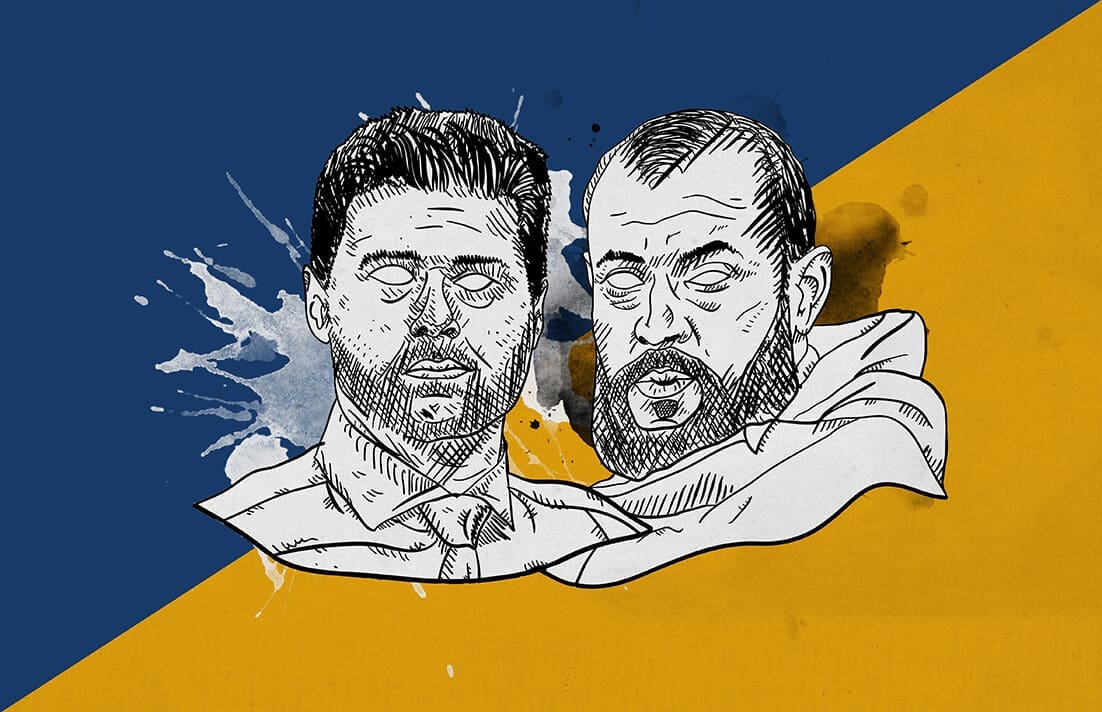


Comments